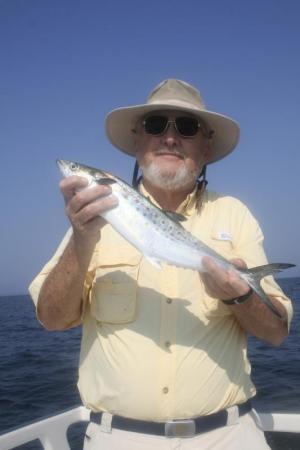When I first began fishing in the ocean back in the late 1960s and early 1970s, we did more trolling than bottom fishing. We had big bluefish at B Buoy and bluefin tuna between A Buoy and the Delaware Lightship. On top of that, there were false albacore in the fall along with Atlantic bonita, all of which were easier to catch by trolling than casting.
Today, flounder and black sea bass make up most of the action in the near-shore ocean, and trolling has fallen out of favor. What anglers fail to realize is the arrival of Spanish and king mackerel plus dolphin on the inshore grounds. These fish will respond to a trolled lure long before they will hit cut bait or a lure that is cast and retrieved.
To be effective, I believe you should use a conventional outfit when trolling. Spinning tackle was not designed for trolling, and it does not work nearly as well in that application as a conventional outfit.
Back in the day, I used Penn 113H Senators with 30-pound mono line for most of my trolling work. Today that seems much too heavy with the much-lighter reels available. I now have a Tsunami HYBRID star drag reel with 30-pound braid, but all the major manufacturers make reels and rods that are suitable for trolling inshore species.
The choice between mono and braided line is, as always, a matter of personal taste. I go with mono when trolling because it is much more forgiving. Mono has stretch and braid does not. This stretch acts as a shock absorber when a fish hits so the hook does not pull out of its mouth. This stretch also protects from pulling the hook during the fight should the fish go with head shakes or jumps.
Braid, on the other hand, will help getting a deep-diving plug down deeper. Braid has a thin diameter that will cut through the water with less resistance than mono. I use braid when trolling with Stretch 25s or 30s and any other deep-diving plugs.
When rigging up for trolling, always attach a good-quality ball bearing snap swivel between the running line and the leader to the lure. As an example, when I rig up for trolling with a Stretch 25, I will tie a ball bearing snap swivel to my braid running line with a clinch knot. A perfection knot on the end of my 6-foot, 20- or 30-pound Fluorocarbon leader will attach it to the snap swivel. The leader will attach to the plug with a Cross-Loc snap. This is the setup I will use when trolling for striped bass or king mackerel.
False albacore, bonita and Spanish mackerel like a smaller bait. Here, a size 0 Drone spoon behind a trolling sinker or #1 planer will do the trick. Spoons need a very long leader to work properly. For Spanish, I use 30 feet of 15-pound mono leader tied to a ball bearing snap swivel that is attached to a trolling sinker weighing from one to four ounces, or to a planer. Planers require a heavy rod, and I use a Shakespeare Sturdy Stick solid glass with a Penn Jigmaster reel filled with 30-pound braid. Not much sport with a Spanish on this outfit, but it will put meat in the box. The same setups will work for bonita and false albacore.
One of the best locations for trolling over the past few years has been the wrecks at Fenwick Shoal. Spanish mackerel and bluefish have been caught there in good numbers, but this year with only a three-fish bag limit for blues on private boats, it may not be worth the effort.
I believe I would wait until later in the summer when the ocean water has warmed to the upper 70s or even the 80-degree mark and try trolling along the channel between B Buoy and the Delaware Lightship. I have caught Spanish, kings, bonito, blues and false albacore along here in the past, and there is no reason why they would not be here now.
Keep an eye on the sky looking for birds and the other eye on your SONAR looking for bait and fish. If you see good concentrations of bait or fish, work that area for a while; don’t just pass it over. If you see birds diving, go over there and see what they are after. Blind trolling while talking or daydreaming might catch a fish now and then, but actually fishing while out on the ocean is usually more productive.
Fishing report
A few tog on boats out of Ocean City, Md., and some perch out of the Broadkill River seem to be all we have seen so far. Warmer weather means warmer water, so fishing will improve very soon.

























































